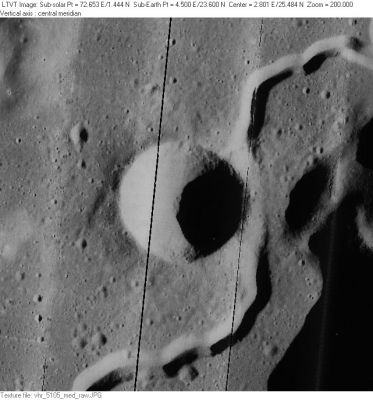Hadley C
Contents
Hadley C
(formerly Hadley and before that Hadley C (as at present))
|
Lat: 25.46°N, Long: 2.8°E, Diam: 5.8 km, Depth: km, Rükl 22 |
LO-V-105M Hadley C is in the center, with a small part of Rima Hadley touching it on the east. The dark shadow along the right margin is cast by sunlight streaming over unnamed low hills that are part of Montes Apenninus.
Images
LPOD Photo Gallery Lunar Orbiter Images Apollo Images
Maps
(LAC zone 41B4) LAC map Geologic map LM map LTO map
Description
This simple crater on the rim of Rima Hadley is of interest primarily because of its odd nomenclature history.
Wikipedia
Additional Information
- IAU page: Hadley C
Nomenclature
- Named for John Hadley (1682-1744), a British instrument maker.
- In the original IAU Nomenclature of Blagg and Müller (1935), Hadley (the mountain) had two lettered craters associated with it: Hadley A and Hadley B.
- In 1964, the name Hadley C (for the present feature) was added as part of the IAU-approved System of Lunar Craters (IAU Transactions XIIB). At the same time the name of the nearby mountain (for which all three craters were named) was Latinized to the present Mons Hadley. A few years later the IAU began advocating the replacement of lettered designations with unique names, and the makers of the LTO charts embraced the plan, converting Hadley A to Joy and Hadley B to Santos-Dumont (Joy appears in the cumulative list of approved changes published in IAU Transactions XVB (1973), but I am unable to find any other record of its actual approval in the IAU Transactions; Santos-Dumont was approved by the IAU in 1976 (IAU Transactions XVIB)). Since the mountain had been renamed, the unadorned name Hadley seemed available and this name was provisionally assigned to the former Hadley C on LTO 41B4 (1975). The change was also unofficially reported in Ashbrook, 1974.
- Although several of the other name changes proposed on that LTO were rejected, this particular change was approved in IAU Transactions XIXB (1985). However objections were soon raised because of the possibility of confusion with the mountain, and the decision was apparently rescinded, although the exact date on which the name was withdrawn is unclear. The status of the feature name (was it Hadley?, Hadley C?, or unnamed?) was also unclear until 2006 when the IAU General Assembly agreed to restore to the IAU Planetary Gazetteer the names of all lettered craters appearing in NASA RP-1097 which did not have subsequently approved replacement names. Since Hadley C did not have an approved replacement, it seems this means the former lettered name was reinstated. However, the same logic does not seem to have been universally applied. For example, the crater Euclides D had been renamed to Eppinger, a new name which was also susequently dropped. Yet when the lettered names were reinstated in 2006, that name was not restored (or at least it does not appear in the on-line IAU Planetary Gazetteer). - Jim Mosher
LPOD Articles
Bibliography
